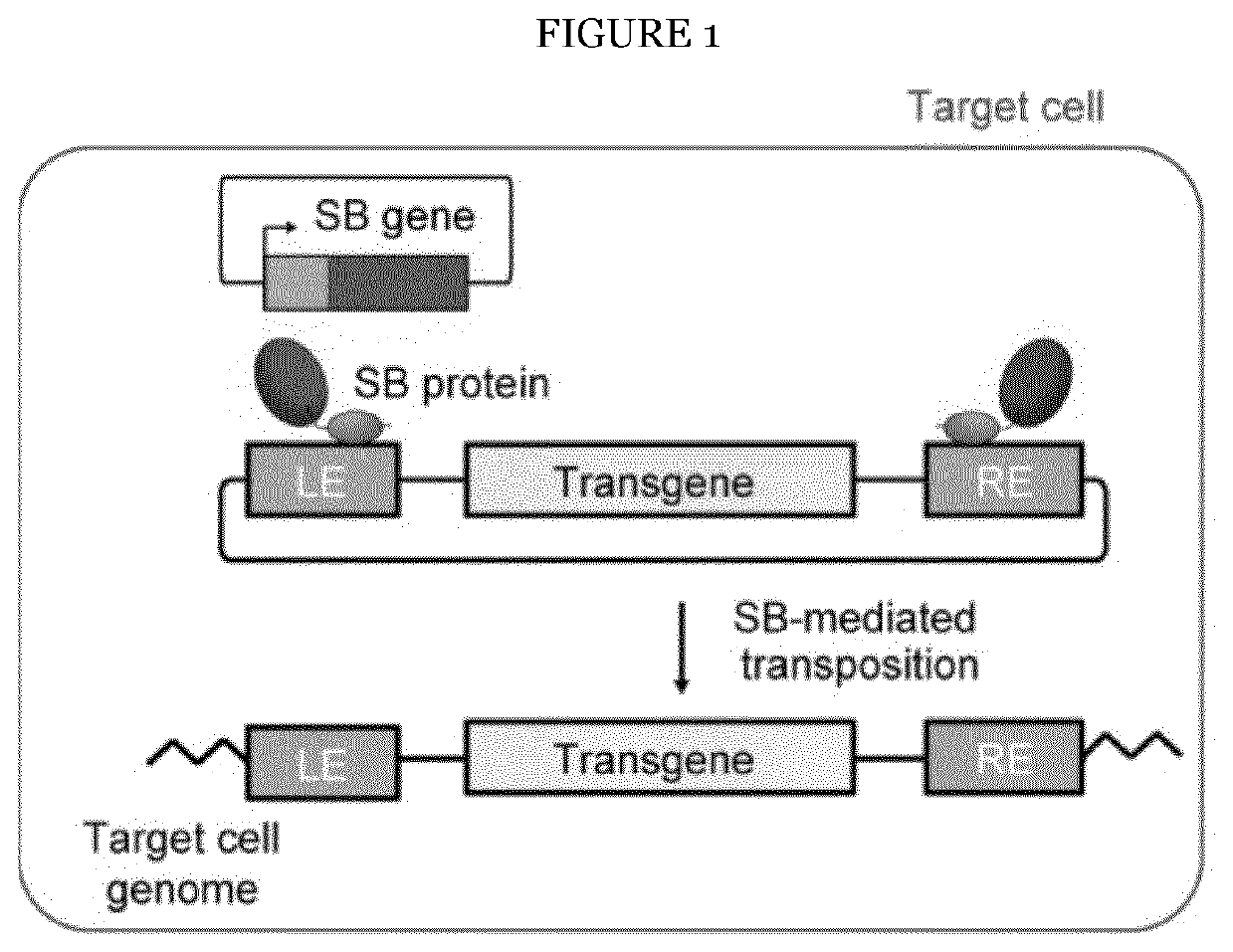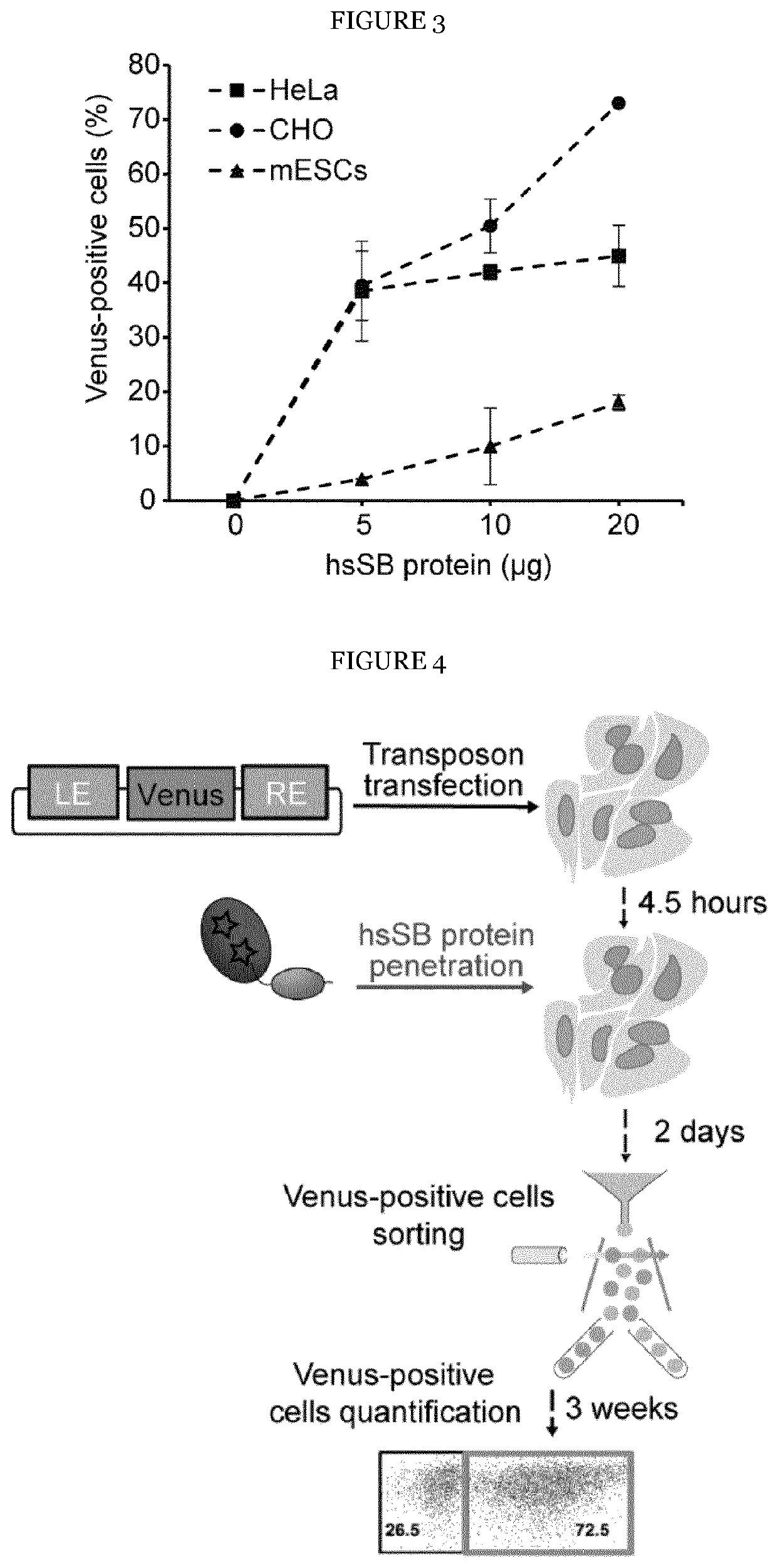Cell penetrating transposase
- Summary
- Abstract
- Description
- Claims
- Application Information
AI Technical Summary
Benefits of technology
Problems solved by technology
Method used
Image
Examples
example 1 (comparative)
in Mammalian Cells Using hsSB Transposase
[0084]A high solubility Sleeping Beauty (hsSB) transposase developed by the inventors was tested in various mammalian cells lines for its ability of genetically engineering cells. The amino acid sequence of the improved hsSB transposase is shown in SEQ ID NO: 3. To better quantify hsSB-mediated transposition, the inventors applied a fluorescent reporter system and transfected HeLa cells with a transposon plasmid containing the Venus gene, followed by hsSB protein delivery by protein electroporation. Cells that acquired the transposon plasmid were selected by fluorescence activated cell sorting 2 days post-transfection. The transposition efficiency was then quantified three weeks later by flow cytometric analysis of green fluorescent cells that stably expressed the Venus reporter gene as a consequence of genomic insertion by hsSB (FIG. 2). A clear, dose-dependent increase in the percentage of fluorescent cells, with the maximum efficiency (42%...
example 2
se has Intrinsic Cell Penetrating Properties
[0085]For further developing methods for the genetic engineering of mammalian cells the inventors sought to make transposase delivery simpler and gentler. Remarkably, the inventors observed that the transposase protein autonomously penetrates HeLa cells and enters the nucleus when simply added to the culture medium (FIGS. 4 and 5). To test if hsSB can mediate transposition when delivered this way, the inventors transfected HeLa cells with a MC containing the Venus gene and then added hsSB to the culture medium without a further pulse or use of a transfection reagent (FIG. 4). Longitudinal Western blot analysis showed hsSB uptake within 4 hours, followed by clearance already 24 hours after delivery (FIG. 6). Fluorescent cell sorting 3 weeks post transfection revealed up to 12% Venus-positive cells (FIG. 7), demonstrating that hsSB mediated efficient transgene integration.
[0086]Next, a similar procedure for genetic engineering of human iPSCs...
example 3
etic Engineering Method can be Used to Generate CAR-T Cells
[0087]Finally, it was tested whether the intrinsic cell penetration property of hsSB can be exploited for CAR T cell manufacturing (FIG. 10). As electroporation is a stress factor for T cells, hsSB penetration could help preserve their fitness for downstream clinical use. The inventors first analyzed hsSB penetration in primary T cells by immunofluorescence imaging, which showed efficient protein uptake in both stimulated and non-stimulated cells within 3 hours (FIG. 11). hsSB efficiently entered the nucleus also in non-dividing cells, consistent with active transport using its intrinsic nuclear localization signal. To probe transposition, T cells were electroporated with CD19 CAR MC and hsSB was added to the cell culture media. This successfully generated human CD8+ CD19 CAR T cells at an overall transgenesis frequency of 5-7% (FIG. 12). CAR T cells were then enriched up to 90% purity by MACS (44) and showed potent lysis of...
PUM
| Property | Measurement | Unit |
|---|---|---|
| Fraction | aaaaa | aaaaa |
Abstract
Description
Claims
Application Information
 Login to View More
Login to View More - R&D
- Intellectual Property
- Life Sciences
- Materials
- Tech Scout
- Unparalleled Data Quality
- Higher Quality Content
- 60% Fewer Hallucinations
Browse by: Latest US Patents, China's latest patents, Technical Efficacy Thesaurus, Application Domain, Technology Topic, Popular Technical Reports.
© 2025 PatSnap. All rights reserved.Legal|Privacy policy|Modern Slavery Act Transparency Statement|Sitemap|About US| Contact US: help@patsnap.com



